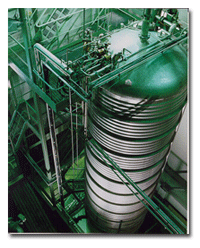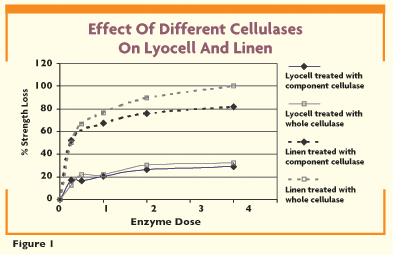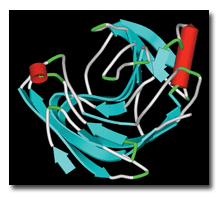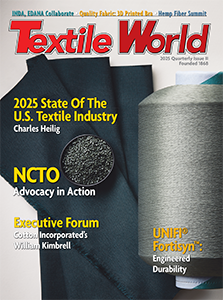M
odern society expects biotechnology to be the answer for many worldwide problems like
depletion of energy sources, incurable illnesses and pollution, among other problems.
Industrial use of biotechnology, known as white biotechnology, is bringing about new products
and processes aimed at the use of renewable resources, as well as the application of green
technologies with low energy consumption and environmentally healthy practices.
Textile processing is a growing industry that traditionally has used a lot of water, energy
and harsh chemicals — starting from pesticides for cotton-growing to high amounts of wash waters
that result in waste streams causing high environmental burdens. As textile fibers are polymers,
the majority being of natural origin, it is reasonable to expect there would be a lot of
opportunities for the application of white biotechnology to textile processing. Enzymes —nature’s
catalysts — are the logical tools for development of new biotechnology-based solutions for textile
wet processing.
Though the focus on white biotechnology is a new phenomenon, the use of enzymes in textile
treatment has a long history. Biotechnology-based processes were applied nearly 2,000 years ago,
when microbes were used as aids in bast fiber-retting. The first enzyme application, as early as
1912, was the use of barley for removal of starchy size from woven fabrics. The first microbial
amylases were used in the 1950s for the same desizing process, which today is routinely used by the
industry. Since then, several other enzymes have been introduced for industrial applications; and
enzymes such as cellulases, catalases, laccases and pectinases are increasingly gaining a foothold
in the textile industry as improved application processes are developed. The use of enzyme
technology is attractive because enzymes are highly specific and efficient, and work under mild
conditions. Furthermore, the use of enzymes results in reduced process times, energy and water
savings; improved product quality; and potential process integration. Following is a review of
common enzymes currently used in textile applications.

Cellulase For Look,
Surface And Hand Modification
Cellulase enzymes were first
introduced after decades of amylase usage as an industry standard for desizing processes. During
the 1970s, the popularity of denim garments increased as new garment wet processes changed denim’s
look and feel from the hard, dark blue garments used as workwear into soft and smooth fashion items
with an abraded look. Surprisingly, this look, first achieved by using pumice stones, also can be
attained using cellulase enzymes. Cellulases loosen the surface fibers of the denim garment so that
mechanical action in a washing machine breaks the surface to remove the indigo dye, revealing the
white core of the ring-dyed yarns. The first cellulase products for this application were
introduced in the 1980s, and today, most denim garments are “stonewashed” using cellulases, either
alone or in combination with a reduced amount of stones. The introduction of cellulases resulted in
increased washing capacity for the laundries, and reduced damage to garments as well as to washing
machines, in addition to diminishing environmental effects from pumice stone mining and disposal of
used pumice.
It also was realized that cellulase applications could be extended to surface and hand
modification of cellulosics. The small fibers or fibrils protruding from the fabric render a fuzzy
surface, and the gradual entanglement of fibrils results in the formation of pills when a garment
is worn and washed. Removal of surface fibrils improves fabric quality, keeping the garment in good
form for a longer time. The use of cellulases, combined with the synergistic action of the
processing machines, is effective in removing the fibrils, leading to permanent improvement of
fabric quality, including cleaner and smoother surface, softer hand and improved fabric drape. This
treatment, called biopolishing, is widely used today in garment processing and in batch processing
of woven and knitted fabrics. As today’s process needs a dwell time of 20 to 40 minutes in a
high-mechanical-action system, the challenge is to create a consistent, continuous biopolishing
process.
Cellulases have been used in the textile industry for approximately two decades for denim
stonewashing and biopolishing of garments and fabrics. The first generation of products was based
on the natural ability of certain microbes to degrade cellulose. In their growth environment, these
microbes excrete a wide variety of proteins, which work in several ways to break down cellulose.
The development of modern biotechnology brought tools with which scientists could create new,
better enzymes for specific applications. Using these tools, it has been possible to create a new
generation of cellulase products containing different kinds of protein molecules or molecule
blends, thus offering improved performance features compared to the naturally occurring enzyme
systems.
Genetic engineering was used to enhance the desired activities of the cellulase complex and
delete the undesired molecules. This work resulted in several patents with claims of improved
performance based on selection of the right types of cellulase molecules. Enzyme manufacturers were
able to come up with new products, which could be enriched in endoglucanase activity, deleted in
the exo-acting cellobiohydrolase activity, or even be based on a single type of cellulase molecule.
As different fabric types have varying susceptibility for cellulase hydrolysis, and different
enzymes vary in their aggressiveness, choosing the right type of enzyme is essential to optimize
the result on a certain fiber type. Figure 1 shows a good example of how different fibers perform
under the same biofinishing treatment conditions: Lyocell, which is an extremely strong fiber that
is resistant to cellulase hydrolysis, does not lose much of its strength after treatment; whereas
linen, which is highly susceptible to cellulase attack, can be destroyed easily by the same
treatment.

Catalse For
Sustainable Hydrogen Peroxide Removal
Today’s textile processing industry uses a lot of hydrogen peroxide for bleaching of greige
goods before dyeing or printing. After the bleaching process, the residual peroxide in the bath
needs to be removed before the fabric enters the dyeing process, as the presence of peroxide
changes the dye shade and causes an uneven dyeing result. Traditionally, peroxide removal has been
done using several consecutive rinses with plentiful water, or using reducing chemicals such as
bisulphite to break down the peroxide. Both methods are unreliable and call for high water
consumption. A more modern way to remove peroxide involves the use of a catalase enzyme, which
breaks down hydrogen peroxide into water and molecular oxygen. The advantage of this process is the
end products are natural to the environment and do not disturb the dyeing process. Also, the
catalase enzyme itself is very specific: When the peroxide is gone, the enzyme does not react with
anything else, and thus there is no need to remove or inactivate it. The use of catalases has been
the fastest-growing enzyme application in textiles in recent years.
The first uses of biotechnology for textile processing have encouraged scientists to further
explore the use of enzymes. Although the biggest market today is for the use of cellulases in denim
washing, there is a willingness to step out of the “denim box” in order to create applications that
would impact the whole industry. The use of catalases is a good first step towards this goal. It
simplifies the bleaching process — giving more reliability in peroxide removal, thereby
guaranteeing consistency for subsequent dyeing. The reductions in water consumption and wastewater
disposal further add to total process cost savings.
Pectinases For
Sustainable Cotton Pretreatment
Today, efforts within the textile
industry seem to focus on replacing traditional natural-fiber scouring processes with enzyme-based
solutions. As the purpose of scouring is to remove natural impurities — such as polymeric
substances like pectins, waxes and xylomannans, among others — from cotton or other natural fibers,
there are plenty of enzymes that can act on such impurities. Alkaline pectinase, which loosens
fiber structure by removing pectins between cellulose fibrils and eases the wash-off of waxy
impurities, is the key enzyme for a bioscouring process. Other enzymes including cellulases,
hemicellulases, proteases and lipases have been tested; but at present, the only commercial
bioscouring enzyme products are based on pectinases.
Compared to the conventional alkaline boil-off, an efficient bioscouring process provides
many advantages, such as reduced water and wastewater costs, reduced treatment time and lower
energy consumption because of lower treatment temperature. Moreover, the weight loss in fabric is
reduced, and fabric quality is improved with a superior hand and reduced strength loss.
However, there are several obstacles in the way of successfully commercializing the
bioscouring process, primarily its inability to remove motes — the remainders of cottonseed
fragments. Thus, a separate bleaching step would be needed after the bioscouring process. On the
other hand, the alkaline boil-off can be combined with simultaneous peroxide bleaching to
efficiently remove the motes. As motes are not acceptable on fabrics other than those that will be
dyed to dark shades, bioscouring will have limited usage unless a simultaneous mote-removal process
is developed.
Another limitation of pectinase treatment is that its efficiency varies with the quality of
fabric. As the enzyme does not break down waxes, a high-temperature treatment with surfactants is
needed for a sufficient degree of hydrophilicity to guarantee even dyeing or printing. The
enzymatic treatment also is limited to discontinuous processes, as the enzyme needs reasonably long
reaction times, and controlling its performance in a continuous process is difficult.

Enzymes For Other Textile Applications
In order to create a successful bio-based pretreatment for fabrics, it would be essential to
develop an enzymatic bleaching process, which is being investigated. The group of enzymes called
laccases, or phenol oxidases, possesses the ability to catalyze the oxidation of a wide range of
phenolic substances, including indigo. Laccases alone are not effective as bleaching agents, but
need to be applied with a mediator molecule, which is the actual substrate of the laccase and which
mediates electron transfer from, for example, indigo to molecular oxygen. The first commercial use
of laccases in the textile industry has been in the denim-washing process, where laccase-mediator
systems have been used to reduce backstaining, enhance abrasion levels and bleach indigo. However,
it has not been possible to show bleaching effects with a laccase-mediator system on greige cotton.
Another approach for enzymatic bleaching would be creation of peroxide in situ. This
approach of using enzymes like glucose oxidase to create hydrogen peroxide from glucose and
molecular oxygen has been discussed in several scientific publications. In principle, it is
possible to use amylases to break down starchy sizes into glucose, and then oxidize this glucose
into gluconic acid and hydrogen peroxide in a combined desizing-bleaching process. This process,
however, does not seem to have reached a state of commercial feasibility.
Finally, peroxidases, which are able
to activate peroxides in mild conditions, have been studied for applications in textile bleaching
processes. However, their use has not shown a satisfactory bleaching effect so far.
An efficient biopreparation process should be based on a combination, preferably
simultaneously, of enzymes for desizing, scouring and bleaching in one bath. Success in developing
such a process would result in a simple process, including savings in water, time and energy
consumption. The environmental impact would be minimized by low to no use of harsh chemicals and
lowered waste burdens, rendering a fabric of higher quality.
The Future Of White Biotechnology
Today, white biotechnology is geared
towards creating new materials and biobased fuels from agricultural waste and providing alternative
biobased routes to chemical processes. These efforts could lead to the development of improved
enzymes such as amylases, hemicellulases or cellulases that could be used in the textile industry.
The possibility of leveraging innovations over industries could lead to new opportunities for
biobased textile processes. New enzymes with high specific activity, increased reaction speed, and
tolerance to more extreme temperatures and pHs could result in development of continuous processes
for bioscouring or biofinishing of cellulosic fibers. Development of other processes in the future
could also expand the use of enzymes on natural fibers into use on man-made fibers such as nylon
and polyester.
Editor’s Note: Anna-Liisa Auterinen is director, textile products, Genencor International BV,
The Netherlands.
May/June 2006





